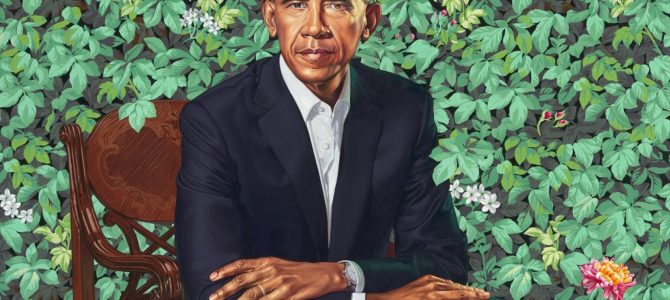
The recent unveiling of President Obama’s presidential portrait has brought much criticism because of its untraditional style. But after having a look at every portrait of every president since the very beginning, I like President Obama’s portrait. It is not only accurate, but refreshing, suitable for both the man and for the moment, in both negative and positive ways. In that sense, it achieves what we need art to be.
So before we criticize this new stuff, take a look at the old and familiar.
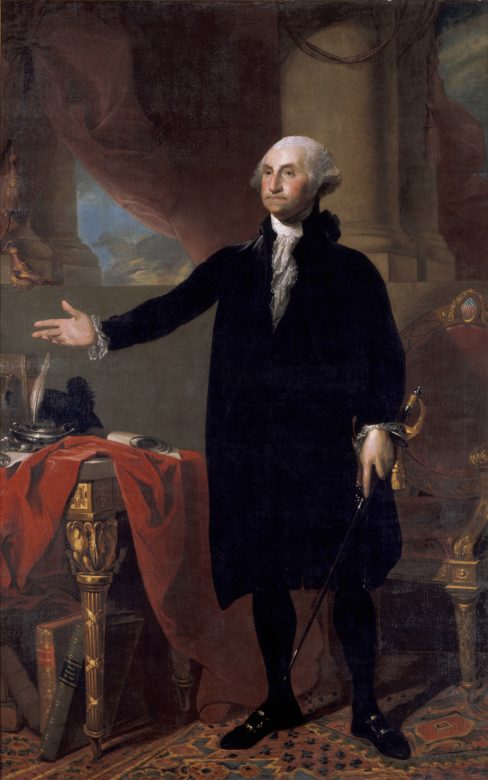
We know of George Washington’s portrait painted by Gilbert Stuart, titled the “Lansdowne Portrait.” It includes a number of symbols, including fasces (a symbol for authority), the original flag (in the head of the chair), pen and paper (symbols for rule of law), books labeled, “American Revolution,” “Constitution and Laws of the United States,” the Federalist Papers, and so on.
Washington’s pose depicts him renouncing a third term (an act that earned him praise from King George as “the greatest man in the world”). Dolley Madison and her servants rescued it from ruin by the British, and it hangs in the East Wing of the White House today. We do not look at this painting and think of him as a god or a monarch. We see him as a great man.
It is an accurate portrait. It tells a story both in its physical history as well as in its presentation, one that truthfully conveys who we know Washington to be. It also ensures (along with Mrs. Madison’s efforts) that an image of our first chief executive is saved for posterity.

Run through the subsequent portraits, and they begin to blend together. James Madison and James Monroe look different enough, but only upon closer inspection do these portraits convey differences. Those that stand out are really great. Andrew Jackson poses with a storm behind him, conveying not only his line that “I was born for the storm, that the calm does not suit me,” but also that he resolved a number of major challenges facing the young country.
Abraham Lincoln is a missed opportunity but still conveys his characteristic willingness to listen to advisers. Woodrow Wilson looks exactly as standoffish and insufferable as he probably was. Calvin Coolidge is the model of simplicity, in a simple chair that could be found more or less anywhere. The portrait of Richard Nixon is unusual because its painter, Norman Rockwell, shows a depth rarely captured in the press (perhaps for good reason).
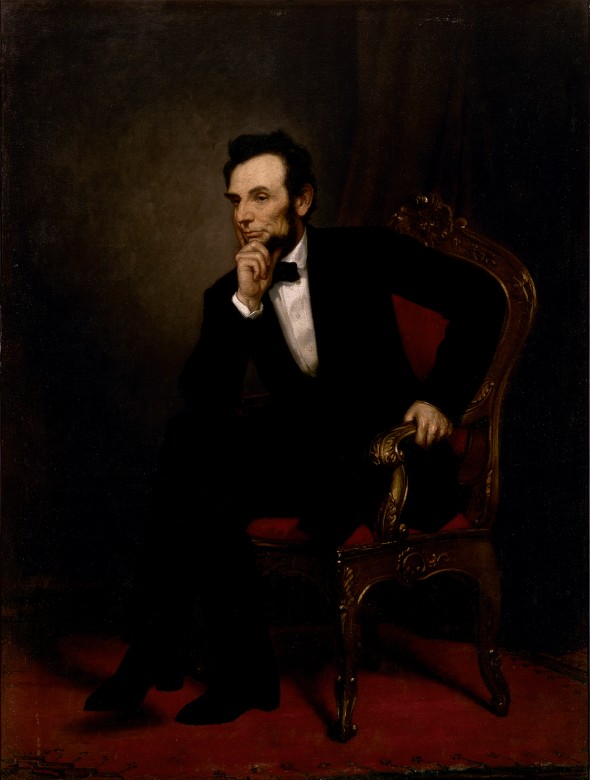
Today, the tools of democracy are different, and so is the need for a portrait of a president. For better or worse, you don’t have to wait long to hear what a political figure thinks on a controversial matter. He can just tweet about it. A campaign stop in Iowa draws attention from a fleet of national publications, instead of just locals. Political life invades every part of private life, and it is no longer possible for anyone—except maybe mountain hermits and still-marooned Japanese soldiers from World War II—to be unfamiliar with the face of the president.
The portrait just ain’t what it used to be. Have you commissioned a portrait? Who does, at least to this kind of fanfare? Maybe to commemorate a loved one, but digital photography and video has turned the page on its necessity. Do you think of presidents these days in terms of their portraits?
Do you think of Ronald Reagan in his brown suit on the patio, or do you think of him delivering the Evil Empire speech? Do you think of Bill Clinton with his hand in his pocket, showing off his challenge coins, or do you think of him biting his lower lip and wagging his finger at you and every other jerk who wouldn’t let him forget about scandal so he could go back to doing his job? Do you think of George W. Bush with a megaphone at Ground Zero, in a flight suit in front of a “Mission Accomplished” banner, or with his hand on his desk?
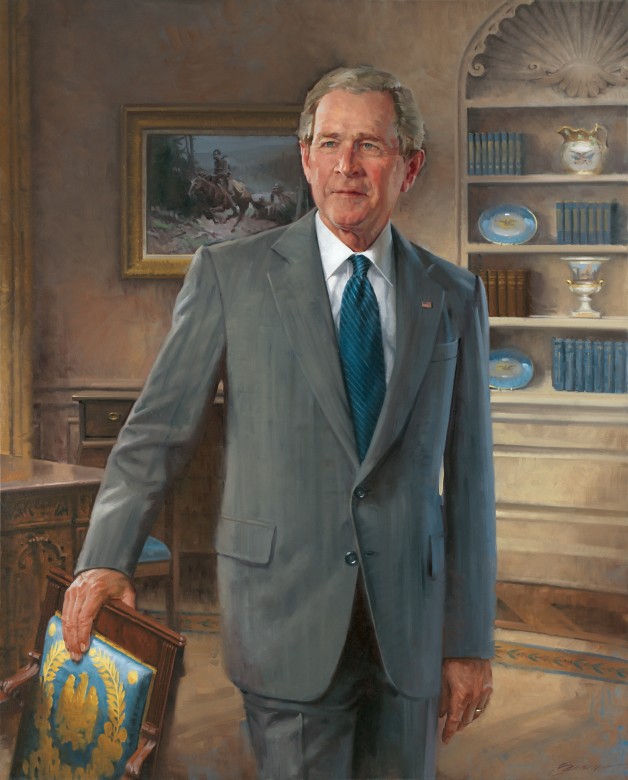
It’s a tradition overdue for change. So who better to change it than the first African-American president, one who often broke with traditions he felt (rightly or wrongly) superficial, burdensome, or dumb? And painted by the first African-American painter of a presidential portrait?
Consider the format—basically pop art. This is great. America’s dynamic art culture has long been stagnant in the area of presidential portraiture, but it wasn’t always thus. Europe, which was obsessed with weird cloudy paintings of people, decried America’s style of painting (started by John Singleton Copley) with its hyper-realistic lines. Copley died thinking himself a failure, but not before teaching Stuart a few lessons that would come in handy for his Washington portrait. In other words, even America’s early art celebrated breaking with tradition.
So it’s good that this is a portrait you’d be as likely to see on the Wynwood Walls or the Broad in L.A. As with much pop art, the principle figure, the American president, is removed from his context in the White House and placed in front of green foliage, portions of which represent his personal biography. His story was central to his rise to the presidency. His personal charisma, his good looks, his style are central here.
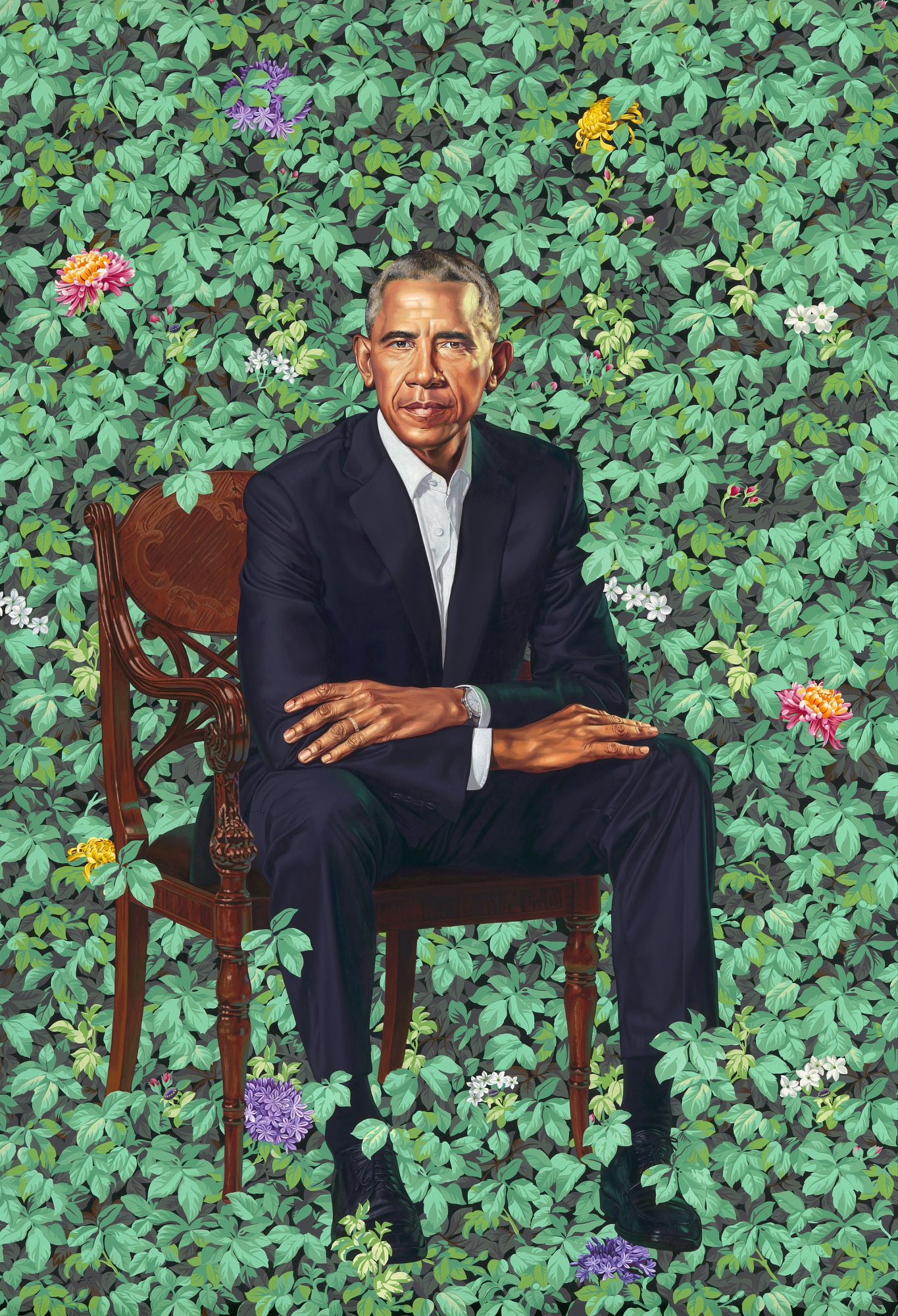
This portrait is an abstraction like Jackson’s clouds, but no less true that a jasmine stud from Hawaii, or a chrysanthemum from Chicago, or, heh, a blue lily from Kenya, are symbols for biographical factors that loomed large in the Obama presidency. In fact, the only thing suggesting that Obama was ever president is the chair, and the fact that a portrait was drawn up at all.
If this portrait were about Obama the president, what should be included that he’d be proud of? The raid on Abbottabad that killed Osama bin Laden? But that was a shared victory—the achievement was of the Navy commandos who did the raid. What about his withdrawal of forces from Iraq? The collapse that followed might detract from the successful delivery on a campaign promise. The nuclear deal with Iran, the Syrian civil war, efforts to close Guantanamo Bay, Obamacare? In order: Highly complicated if not divisive, ongoing and getting worse, still happening, still getting litigated or repealed.
Okay then. A portrait of a president’s style and personal biography it is.
It is an accurate portrait. It tells a story both in its physical history as well as in its presentation, one that truthfully conveys who we know Obama to be. It also ensures that President Obama’s legacy stands out in an appropriate style. He broke with tradition. And that’s pretty much it.









